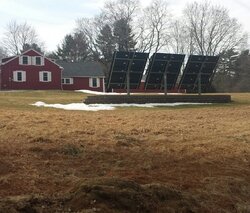Met with the solar guy last night to see if they're an option on our house.
Long story short, says we need about 8 KW of electricity, thus 8 panels, at a cost of about $1000 a panel installed. 25 year warranty, $1000 state (CT) rebate, $2100 federal tax credit, total cost out of pocket $4900 +/-.
Overall, if no one is bs'ing anyone, it would be about a 7 year pay back. We would still have the $17/mo. connection fee from the power company, but he claims that's it.
The real killer is that despite the fact that the house faces due south and gets crazy sun, for the panels to run at a minimum of 80% efficiency (thus qualifying for the tax credits and what not) 3 giant old beautiful historic maples would need to come down, not really an option as far as we're concerned right now.
So, I'm asking if anyone's made the switch to solar, and what your experience has been with it? Are the claims of zero electric bills reality or a sales pitch? 25 year warranty, but what's the real reliability of the product? Any other info anyone can offer up would be helpful as well.
Thanks.
Long story short, says we need about 8 KW of electricity, thus 8 panels, at a cost of about $1000 a panel installed. 25 year warranty, $1000 state (CT) rebate, $2100 federal tax credit, total cost out of pocket $4900 +/-.
Overall, if no one is bs'ing anyone, it would be about a 7 year pay back. We would still have the $17/mo. connection fee from the power company, but he claims that's it.
The real killer is that despite the fact that the house faces due south and gets crazy sun, for the panels to run at a minimum of 80% efficiency (thus qualifying for the tax credits and what not) 3 giant old beautiful historic maples would need to come down, not really an option as far as we're concerned right now.
So, I'm asking if anyone's made the switch to solar, and what your experience has been with it? Are the claims of zero electric bills reality or a sales pitch? 25 year warranty, but what's the real reliability of the product? Any other info anyone can offer up would be helpful as well.
Thanks.


